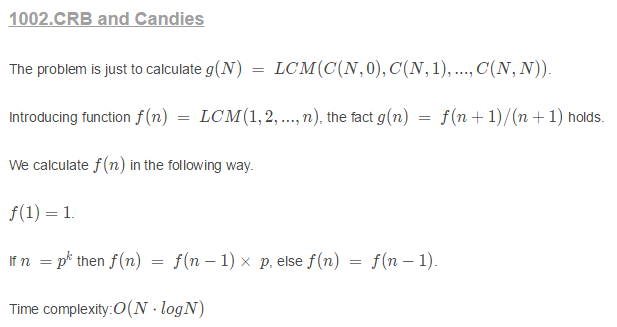CRB and Candies
He wonders how many combinations he can select.
Can you answer his question for all K (0 ≤ K ≤ N )?
CRB is too hungry to check all of your answers one by one, so he only asks least common multiple(LCM) of all answers.
1 ≤ T ≤ 300
1 ≤ N ≤ 106
5 1 2 3 4 5
1 2 3 12 10
可以说,该题是本场多校出题最快的一题了,做的人也挺多,但貌似就个人而言,觉得并不是一道简单的题,首先一个等价式就已经不知道了
再者最后用快速幂来处理除法取模的问题也是我目前还未知的。
题意:CRB有n颗不同的糖果,先在他要吃掉k颗(0<=k<=n),问k取0~n的方案数的最小公倍数是多少
例如,现有3颗不同的糖果,他吃0颗有1种方案,1颗有3种方案,2颗有3种方案,3颗有1种方案,则解为LCM(1,3,3,1)=3
刚开始拿到这题的时候,和往常一样,找规律,于是开始列了一堆的计算结果 LCM
1 1
1 1 1
1 2 1 2
1 3 3 1 3
1 4 6 4 1 12
1 5 10 10 5 1 10
1 6 15 20 15 6 1 60
1 7 21 35 35 21 7 1 105
1 8 28 56 70 56 28 8 1 280
1 9 36 84 126 126 84 36 9 1 252
然而并没有我要的规律,看了出题人的解题报告,我才知道居然有这样一个等价式
然而,出题人却没有对这个等价式进行证明,怎么想也想不通,这是如何得到的,本打算在这里做一个证明,但是,唉,个人水平有限,只能委屈大家点个链接了
知道这个式子之后,我们要求的就转化成了求LCM(1,2,…,n)了,这个的求法在出题人的报告里有介绍,当n是素数p的k次方时,LCM(1,2,…,n)=LCM(1,2,…,n-1)*p的,否则LCM(1,2,…,n)=LCM(1,2,…,n-1),这个还是比较方便的,先打个素数表,然后将素数的k次方做个标记就可以了,然后再遍历一遍求f(n)=LCM(1,2,…,n)的值,剩下的就是取模工作了
因为f(n+1)/(n+1)是一个除法,而取模运算又是不满足除法的,没办法,看到一些人用了快速幂来求,就有样学样的拿来用了,可是不理解为什么快速幂的时候要mod-2,这个希望有人能帮我解答吧,毕竟相互学习嘛,而乘法逆元,同样也可以点个链接看看
好啦,放个代码,有问题的,我们来讨论讨论,共勉
#pragma comment(linker, "/STACK:1024000000,1024000000")
#include<stdio.h>
#include<string.h>
#include<stdlib.h>
#include<queue>
#include<math.h>
#include<vector>
#include<map>
#include<set>
#include<stdlib.h>
#include<cmath>
#include<string>
#include<algorithm>
#include<iostream>
#define exp 1e-10
using namespace std;
const int N = 1000002;
const int inf = 1000000000;
const int mod = 1000000007;
__int64 f[N],x;
int p[80000],k=0,s[N];
bool v[N];
void get_prime()//素数表
{
memset(v,false,sizeof(v));
for(int i=2;i<N;i++)
if(!v[i])
{
p[k++]=i;
for(int j=i*2;j<N;j+=i)
v[j]=true;
}
}
__int64 Quick_Mod(int a,int b)//快速幂
{
__int64 res = 1,term = a % mod;
while(b)
{
if(b & 1) res = (res * term) % mod;
term = (term * term) % mod;
b >>= 1;
}
return res;
}
int main()
{
int t,n,i;
get_prime();
memset(v,false,sizeof(v));
for(i=0;i<k;i++)
{
x=p[i];
while(x<N)//将素数p的k次方p^k标记一下,方便计算f(n)
{
v[x]=true;
s[x]=p[i];
x*=p[i];
}
}
f[1]=1;
for(i=2;i<N;i++)//计算f(n)
if(v[i])
f[i]=(f[i-1]*s[i])%mod;//f(n)=f(n-1)*p
else
f[i]=f[i-1];//f(n)=f(n-1)
scanf("%d",&t);
while(t--)
{
scanf("%d",&n);
printf("%d\n",(f[n+1]*Quick_Mod(n+1,mod-2))%mod);//计算(f(n+1)/(n+1))%mod
}
return 0;
}


























 1748
1748











 被折叠的 条评论
为什么被折叠?
被折叠的 条评论
为什么被折叠?








